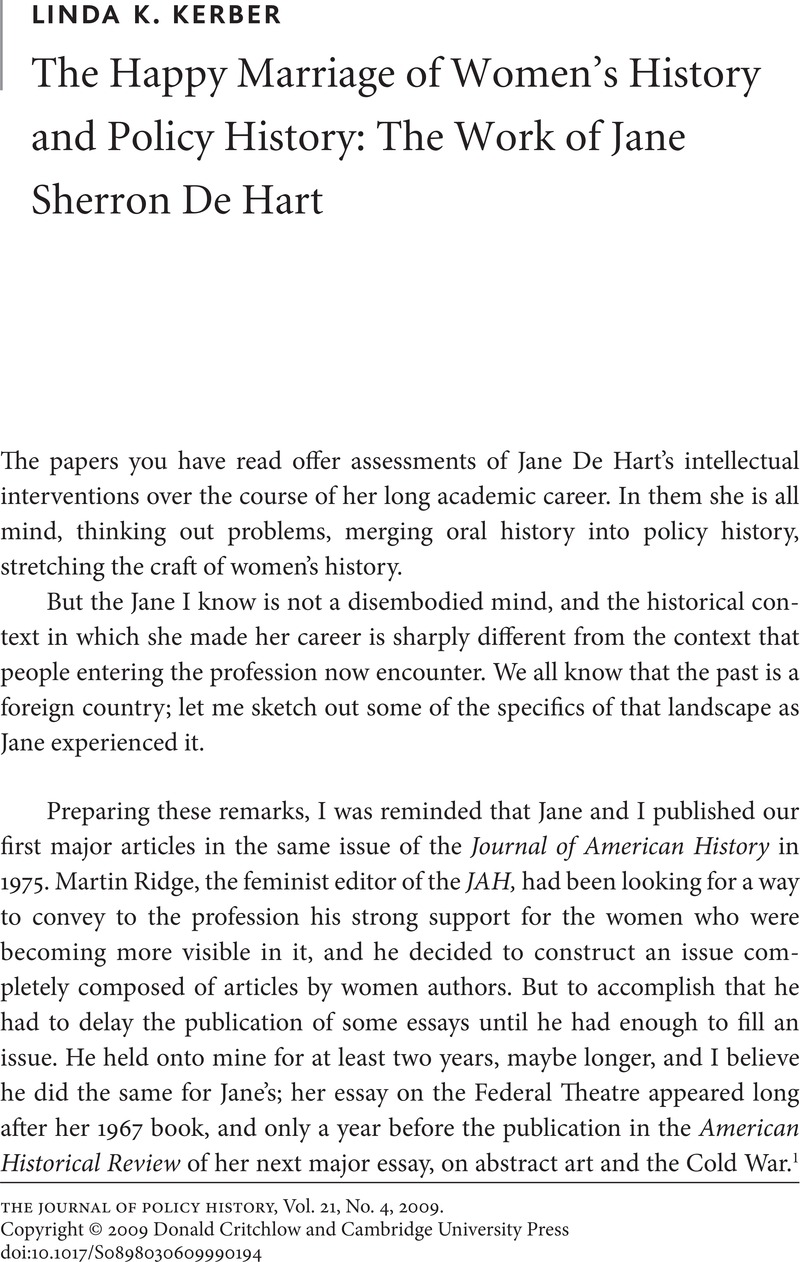No CrossRef data available.
Article contents
The Happy Marriage of Women’s History and Policy History: The Work of Jane Sherron De Hart
Published online by Cambridge University Press: 01 October 2009
Abstract

- Type
- Forum on The Work of Jane Sherron De Hart
- Information
- Copyright
- Copyright © Donald Critchlow and Cambridge University Press 2009
References
NOTES
1. Journal of American History 62, no. 1 (1975): 316–39. Jane’s essay was “Arts and the People: The New Deal Quest for a Cultural Democracy.” Other authors were Sharon Hartman Strom, “Leadership and Tactics in the American Woman Suffrage Movement: A New Perspective from Massachusetts” (296–315); Deborah Wing Ray, “The Takoradi Route: Roosevelt’s Prewar Venture Beyond the Western Hemisphere” (340–58); and Linda K. Kerber, “The Abolitionist Perception of the Indian” (271–95). Jane De Hart’s essay, “Art and Politics in Cold War America,” appeared in the American Historical Review 81 (1976): 762–87.
2. Report of ad hoc Committee on the Status of Women, American Historical Association, November 1970; http://www.historians.org/pubs/archives/Rosereport/index.htm. Citing social science literature, the committee observed, “Prejudiced attitudes are strongest among men who have been in teaching and/or administration for a period of from five to twenty years. This age group may be assumed to constitute the majority of decision makers in almost any department. The least prejudiced attitudes toward women are found in those under 30 and over 60 years of age” (12–13).
3. As co-chair of the American Studies Association Program Committee in 1988, she initiated the practice of devoting the entire program to a single theme; the ASA program that year focused on issues of race, gender, and class. There was, Jane remembers, much resistance to this innovation at the time, but the meeting was an enormous success, and it was a turning point in the ASA’s embrace of ethnic studies and a wider range of disciplines, widening its boundaries from the history-and-literature that had previously defined it.
4. Novick, Peter, That Noble Dream: The “Objectivity Question” and the American Historical Profession (Cambridge, 1988), 493CrossRefGoogle Scholar. The book won the Bancroft Prize.
5. Townsend, Robert, “The Status of Women and Minorities in the History Profession, 2008,” Perspectives, September 2008, at http://www.historians.org/perspectives/issues/2008/0809/0809new1.cfmGoogle Scholar
6. This situation persists; it has recently been described by Mason, Mary Ann and Goulden, Marc, “Do Babies Matter? Part II, Closing the Baby Gap,” Academe (AAUP) 90, no. 6, at http://www.aaup.org/AAUP/pubsres/academe/2004/ND/Feat/04ndmaso.htm.Google Scholar


